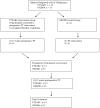Feasibility and functional outcomes of children and adolescents undergoing preoperative chemotherapy prior to a limb-sparing procedure or amputation
- PMID: 28948112
- PMCID: PMC5609724
Feasibility and functional outcomes of children and adolescents undergoing preoperative chemotherapy prior to a limb-sparing procedure or amputation
Abstract
Background: Survivors of lower extremity (LE) malignancies experience functional deficits.
Purpose: The purpose of this prospective clinical trial was to determine feasibility and functional outcomes of adding pre-habilitation during the 10-12 week period prior to a planned surgery to remove the tumor in children and adolescents with a LE sarcoma.
Design: Pilot study.
Setting: St. Jude Children's Research Hospital (SJCRH).
Patients: Participants included 14 individuals between the ages of 8 and 20 years who were diagnosed with a LE sarcoma. Participant outcomes were compared to a control group of 35 individuals treated for osteosarcoma that obtained the same functional assessments but no pre-habilitation.
Intervention: The intervention group received strengthening exercises and mobility training 3 times per week for 30-60 minutes for 10-12 weeks preoperatively.
Measurements: Participants completed the Functional Mobility Assessment (FMA) and measures of strength and range of motion (ROM) of bilateral lower extremities (BLEs) at baseline, after 10-12 weeks of preoperative PT, and at 20-22 weeks.
Results: Twelve participants completed at least 50% of their schedule pre-habilitative sessions. The intervention group scored significantly better on the FMA than the control group at weeks 20-22 (35.6 vs. 25.7, p .0267). No significant difference was found in ROM or strength.
Limitations: Due to this study being a pilot study, the sample size was small. Therefore, we cannot infer generalizability.
Conclusions: Findings suggest that those diagnosed with a LE malignancy awaiting a limb sparing procedure or amputation participate in at least 50% of scheduled PT sessions and benefit from them.
Keywords: Pre-habilitation; adolescents; cancer; exercise; pediatrics; physical therapy; sarcoma.
Similar articles
-
Erratum.Mult Scler. 2016 Oct;22(12):NP9-NP11. doi: 10.1177/1352458515585718. Epub 2015 Jun 3. Mult Scler. 2016. PMID: 26041800
-
Functional progressive resistance training improves muscle strength but not walking ability in children with cerebral palsy.J Physiother. 2012;58(3):197. doi: 10.1016/S1836-9553(12)70111-X. J Physiother. 2012. PMID: 22884187
-
Ballistic strength training compared with usual care for improving mobility following traumatic brain injury: protocol for a randomised, controlled trial.J Physiother. 2016 Jul;62(3):164. doi: 10.1016/j.jphys.2016.04.003. Epub 2016 Jun 16. J Physiother. 2016. PMID: 27320832 Clinical Trial.
-
The Effectiveness of Incorporating a Play-based Intervention to Improve Functional Mobility for a Child with Relapsed Acute Lymphoblastic Leukaemia: A Case Report.Physiother Res Int. 2016 Dec;21(4):264-270. doi: 10.1002/pri.1663. Epub 2016 Feb 19. Physiother Res Int. 2016. PMID: 26892073 Review.
-
Novel Augmentation Strategies in Major Depression.Dan Med J. 2017 Apr;64(4):B5338. Dan Med J. 2017. PMID: 28385173 Review.
Cited by
-
Physical Rehabilitation Practices for Children and Adolescents with Cancer in Canada.Physiother Can. 2020 Spring;72(2):207-216. doi: 10.3138/ptc-2018-0077. Physiother Can. 2020. PMID: 32494104 Free PMC article.
-
Clinical outcomes measurement in pediatric lower limb prosthetics: A scoping review.J Pediatr Rehabil Med. 2024;17(2):147-165. doi: 10.3233/PRM-230014. J Pediatr Rehabil Med. 2024. PMID: 38427511 Free PMC article.
-
Physical therapy interventions, other than general physical exercise interventions, in children and adolescents before, during and following treatment for cancer.Cochrane Database Syst Rev. 2021 Aug 3;8(8):CD012924. doi: 10.1002/14651858.CD012924.pub2. Cochrane Database Syst Rev. 2021. PMID: 34343340 Free PMC article.
-
Promoting positive physical activity behaviors for children and adolescents undergoing acute cancer treatment: Development of the CanMOVE intervention using the Behavior Change Wheel.Front Pediatr. 2022 Oct 13;10:980890. doi: 10.3389/fped.2022.980890. eCollection 2022. Front Pediatr. 2022. PMID: 36313891 Free PMC article.
-
A Scoping Review of Physical Therapy Interventions for Childhood Cancers.Physiother Can. 2019 Summer;71(3):287-296. doi: 10.3138/ptc.2018-13.pp. Physiother Can. 2019. PMID: 31719724 Free PMC article.
References
-
- Bekkering WP, Vliet Vlieland TP, Koopman HM, et al. Functional ability and physical activity in children and young adults after limb-salvage or ablative surgery for lower extremity bone tumors. Journal of surgical oncology. 2011;103(3):276–282. - PubMed
-
- Bekkering WP, Vliet Vlieland TP, Koopman HM, et al. Quality of life in young patients after bone tumor surgery around the knee joint and comparison with healthy controls. Pediatric blood & cancer. 2010;54(5):738–745. - PubMed
-
- Ness KK, Mertens AC, Hudson MM, et al. Limitations on physical performance and daily activities among long-term survivors of childhood cancer. Annals of internal medicine. 2005;143(9):639–647. - PubMed
Grants and funding
LinkOut - more resources
Full Text Sources
Medical

